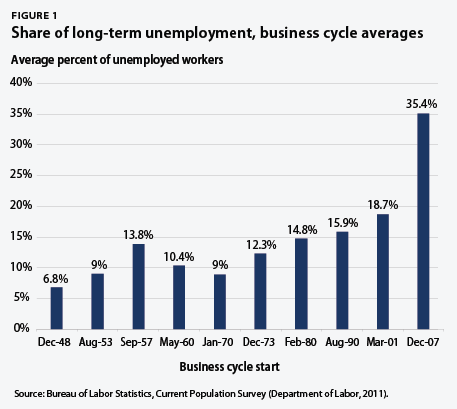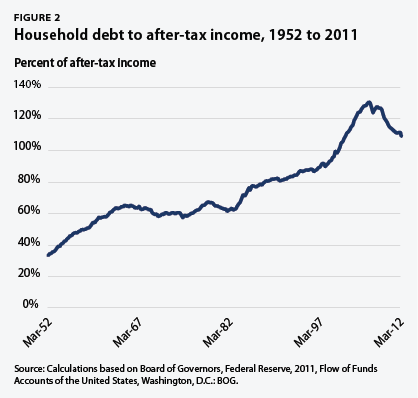The U.S. economy continues to expand modestly, while household debt, lingering wealth losses, fiscal challenges for state, local, and federal governments, and overseas economic crises weigh down economic and job growth. These trends have held back the economy for years, but conservative policymakers have never felt the necessary urgency to respond to the resulting slow recovery in the economy and for jobs. Progressive policy ideas to invest in people and in the economy have thus faced an insurmountable political blockage in Congress, and America’s middle class has paid the price in the form of high economic insecurity during the economic recovery.
The Center for American Progress recently released a report detailing 35 ideas to help the middle class. Many of these policies such as lower mortgage payments and lower student loan payments can offer fast relief to families and thus boost economic growth. Policymakers should not let politics stand in the way of boosting economic and job growth.
1. Economic growth remains positive but modest. Gross domestic product, or GDP, grew at an annual rate of 1.5 percent in the second quarter of 2012. Government spending actually fell by 1.4 percent. Business investment grew by 5.3 percent in the second quarter of 2012, while consumption grew by 1.5 percent, and exports expanded at a rate of 5.3 percent. Government spending cuts reflect the continued fiscal crisis among federal, state, and local governments, as well as declining business investment. The reasonable business investment and export growth were not enough to overcome lackluster consumption and shrinking government spending growth.
2. Competitiveness stays back. Worker productivity—the amount of goods and services produced in an hour of work in the nonfarm business economy—is a key measure of the economy’s global competitiveness. Productivity now stands 7.3 percent larger than it did in December 2007, at the start of the Great Recession, but well below the average increase of 8.5 percent for similar periods in the past.
3. The slow labor market recovery continues. There were 2.7 million more jobs in July 2012 than in June 2009, when the economic recovery officially started. The private sector added 3.4 million jobs during this period. The difference between the net gain and private-sector gain is explained by the loss of 640,000 state and local government jobs, as budget cuts reduced the number of jobs for teachers, bus drivers, fire fighters, and police officers, among others. Job creation is a top policy priority since private-sector job growth is still too weak to quickly overcome other job losses and to rapidly lower the unemployment rate.
4. The suffering of the unemployed stays high. The unemployment rate stood at 8.3 percent in July 2012. Long-term unemployment ballooned in recent years alongside high unemployment rates. In July 2012 still 40.7 percent of the unemployed were out of work and looking for a job for more than six months. The average length of unemployment stayed high, at 38.8 weeks in July 2012. Those out of a job for a long time struggle because job growth has proceeded at a slow place. Millions of unemployed workers thus vie for newly created jobs. (see Figure 1)

5. Labor market pressures fall especially on communities of color, young workers, and those with less education. The African American unemployment rate in July 2012 stayed well above average at 14.1 percent. The Hispanic unemployment rate was 10.3 percent, and the white unemployment rate was 7.4 percent. Youth unemployment stood at a high 23.8 percent. The unemployment rate for people without a high school diploma stayed high at 12.7 percent, compared to 8.7 percent for those with a high school degree, 7.1 percent for those with some college education, and 4.1 percent for those with a college degree. Vulnerable groups have struggled disproportionately more amid the weak labor market than white workers, older workers, and workers with more education.
6. Household incomes continue to drop amid prolonged labor market weaknesses. Median inflation-adjusted household income—half of all households have more and the other half has less—stood at $49,445 in 2010, its lowest level in inflation-adjusted dollars since 1996. It fell again by 2.3 percent in 2010, an accelerated decline after median income dropped by 0.7 percent in 2009. American families saw few gains during the recovery before the crisis hit in 2008 and experienced no income gains during the current economic recovery after 2009.
7. Income inequality is on the rise. Households at the 95th percentile, with incomes of $180,810 in 2010, had incomes that were more than nine times—9.04 times, to be exact—the incomes of households at the 20th percentile, with incomes of $20,000. This is the largest gap between the top 5 percent and the bottom 20 percent of households since the U.S. Census Bureau kept record in 1967.
8. Poverty continues to rise across a wide spectrum. The poverty rate rose to 15.1 percent in 2010—its highest rate since 1993. The African American poverty rate was 27.4 percent, the Hispanic rate was 26.6 percent, and the white rate was 9.9 percent in 2010. The poverty rate for children under the age of 18 stood at 22 percent. More than one-third of African American children (39.1 percent) lived in poverty in 2010, compared to 35 percent of Hispanic children and 12.4 percent of white children. The prolonged economic slump, following an exceptionally weak labor market before the crisis, has taken a massive toll on the most vulnerable.
9. Employer-sponsored benefits disappear. The share of people with employer-sponsored health insurance dropped from 59.8 percent in 2007 to 55.3 percent in 2010. The share of private-sector workers who participated in a retirement plan at work fell to 39.5 percent in 2010, down from 42 percent in 2007. Families have less economic security than in the past due to fewer employment-based benefits, requiring more private savings to make up the difference.
10. Family wealth losses linger. Total family wealth is down $10.9 trillion (in 2012 dollars) from June 2007—its last peak—to March 2012. Homeowners on average own a near-record low of only 40.7 percent of their homes, with the rest owed to banks. Homeowners feel pressure to save more and consume less to rebuild their equity, slowing consumer spending and holding back economic growth.
11. Household debt is still high. Household debt equaled 109.2 percent of after-tax income in March 2012, down from a peak of 129.1 percent in September 2007. The unprecedented fall in debt over the past four years resulted from tight lending standards, falling interest rates, massive foreclosures, and increased household savings. Further deleveraging will likely slow, then, unless incomes rise faster than they have in the past. High debt could therefore continue to slow economic growth, as households focus on saving rather than on spending more. (see Figure 2)

12. The housing market slowly recovers from historic lows. New home sales amounted to an annual rate of 350,000 in June 2012, up from 304,000 in June 2011 but well below the historical average of 698,000 before the Great Recession. The median new house price in June 2012 was 3.2 percent lower than a year earlier.Existing home sales were up by 4.5 percent in June 2012 from a year earlier, and the median price for existing homes was up by 7.9 percent during this period. The housing market has a lot of room to grow and to contribute to economic growth since the tepid recovery in the spring of 2012 started from historically low home sales. (see Figure 3)

13. Homeowners’ distress remains high. One in eight mortgages is still delinquent or in foreclosure even though mortgage troubles have gradually eased since March 2010. The share of delinquent mortgages was 7.6 percent in the second quarter of 2012, and the share of mortgages that were in foreclosure was 4.3 percent at the same time. Many families delayed and defaulted on mortgage payments amid high unemployment and massive wealth losses. Banks may be nervous about extending new mortgages, prolonging the economic slump.
14. Near precrisis peak profits are not reflected in investment data. Inflation-adjusted corporate profits were 97.7 percent larger in March 2012 than in June 2009, when the economic recovery started. The after-tax corporate profit rate—profits to total assets—stood at 3.1 percent in March 2012, near the peak after-tax profit rate of 3.2 percent prior to the Great Recession, dating back to 1952. Corporations used their resources for purposes other than investments in plants and equipment. The share of investment out of GDP stayed low with 10.4 percent in the first quarter of 2012.
Christian E. Weller is a Senior Fellow at the Center for American Progress and an associate professor in the department of public policy and public affairs at the University of Massachusetts, Boston.